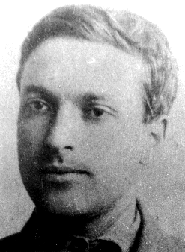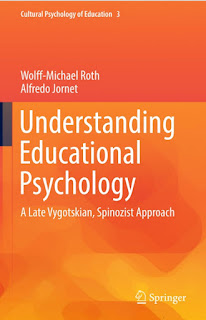Lev Semyonovich Vygotsky (1896 - 1934) probeerde Spinoza toe te passen [4]
 Aan het eind van het blog wijs ik op een recente uitgave waarin geprobeerd wordt het werk van Vygotsky te voltooien. Hier wijs ik nog eens op het in het vorige blog vermelde zeer deskundige artikel van Giovana
Reis Mesquita dat een heel goed beeld geeft van hoe Vygotsky het individu ziet
als opgebouwd uit interacties van de eigen activiteiten te midden van de
culturele context. In deze relaties verwerft het subject de specifieke
instrumenten van taal en denken dat hem of haar in staat stelt te handelen in
de wereld op een verdergaande manier dan (voorbij aan) de informatie die
hij/zij van zijn zintuigen ontvangt. Vygotsky ziet een dialectische relatie
tussen denken en taal. Eerst is er denken, maar het verwerven van
taalvaardigheid veroorzaakt op zijn beurt een diepgaande verandering in het
denken. Zo ontwikkelt zich de psyche en z’n hogere mentale functies via dit
bemiddelingsproces van de taalverwerving. Dit speelt zich vooral op de
kinderleeftijd af (Vygotsky schreef dan ook veel over ontwikkeling van
kinderen), maar is een altijddurend proces. Cf.
Aan het eind van het blog wijs ik op een recente uitgave waarin geprobeerd wordt het werk van Vygotsky te voltooien. Hier wijs ik nog eens op het in het vorige blog vermelde zeer deskundige artikel van Giovana
Reis Mesquita dat een heel goed beeld geeft van hoe Vygotsky het individu ziet
als opgebouwd uit interacties van de eigen activiteiten te midden van de
culturele context. In deze relaties verwerft het subject de specifieke
instrumenten van taal en denken dat hem of haar in staat stelt te handelen in
de wereld op een verdergaande manier dan (voorbij aan) de informatie die
hij/zij van zijn zintuigen ontvangt. Vygotsky ziet een dialectische relatie
tussen denken en taal. Eerst is er denken, maar het verwerven van
taalvaardigheid veroorzaakt op zijn beurt een diepgaande verandering in het
denken. Zo ontwikkelt zich de psyche en z’n hogere mentale functies via dit
bemiddelingsproces van de taalverwerving. Dit speelt zich vooral op de
kinderleeftijd af (Vygotsky schreef dan ook veel over ontwikkeling van
kinderen), maar is een altijddurend proces. Cf.
• Giovana Reis Mesquita (Universidade
Federal da Bahia, Salvador, Brasil), “Vygotsky and the Theories of Emotions: in
search of a possible dialogue.” In: Psicologia: Reflexão e Crítica, vol.25 no.4
Porto Alegre 2012 [geheel te lezen cf.].
Aanbevolen.
Heel andere informatie vinden we bij Andrey Maidansky. Hij gaf in zijn
artikel
• Andrey Maidansky, “The Russian Spinozists” [in: Studies in East European Thought, September 2003, vol. 55, no. 3,
pp. 199-216 cf.] een uitvoerige en zeer informatieve paragraaf over Vygotsky [te
vinden op zijn site]. Ik neem
die paragraaf hierna in z’n geheel over - zonder de eindnoten [als u de noten aanklikt
komt u op zijn site, reist u dus even naar Rusland]. Het voordeel is dat de
Spinoza scholar Maidansky in zijn artikel méér van Spinoza behandelt.
Daarbij vermeld ik ook dat hij (zo is te zien in de Duitse Spinozabibliografie)
enige jaren later tevens nog schreef:
• Vygotsky – Spinoza: dialog skvoz' stoletija [Vygotsky - Spinoza: a
dialog through centuries], in: Voprosy filosofii [The Problems of Philosophy]
10 (2008), 116-127
Hier zijn
paragraaf over Vygotsky in “The
Russian Spinozists”
The
famous Russian psychologist Lev Sem¸novich Vygotskij (1896‑1934) was carried
away with Spinoza’s philosophy when studying it at the historian-philosophical
faculty of the Shanjavskij Moscow University. He was attracted first by
Spinoza’s strict causal explanation of mind by the principle of action of the
human body. Being guided by this principle, Vygotskij established that the
cultural mental functions originate as forms of human activity, which is
directed to the outer (social) world. The distinctive feature of cultural
mental functions in comparison with the natural ones is that the former are
mediated by artificially created stimuli, signs. Using signs, a “thinking
being” actively regulates its own behaviour. This idea, as Vygotskij believes,
allows us “to demonstrate empirically the origin of human free will.” 18
The
traditional model of free will is a “Buridan’s ass” situation, where an ass is
forced to act by two different stimuli in equal extent. Its soul cannot
perceive anything except the states of body, caused by these stimuli, thus the
ass turns out to be unable to act in this or that way and dies.
According
to Spinoza, a man does not merely perceive the states of his own body, which
are caused by external stimuli. The human body is able to “move and dispose” external
things, 19 thereby imparting to itself various
states, which are adequate to (or conform with) the nature of other bodies.
Perceptions of such states of the body constitute the contents of human
intellect. The power of causes, which are perceived adequately by a “thinking
thing” (res cogitans), infinitely exceeds the power of any external
stimuli immediately affecting the human body. Therefore, the better one knows
the nature of things, the smaller is the danger of dying like Buridan’s ass
because of external causes. Herein lies the real freedom. It is directly
proportional to our knowledge of causes of the things we come across or, more
precisely, to our capacity for acting reasonably on external things and, by
means of these things, on our own body and mind.
Spinoza,
however, gives only a general solution to the problem of free will. Admitting
his complete agreement with this solution, 20 Vygotskij makes a series of
experiments with children to verify it. [204]
He
creates a state of the equilibrium of motives and comes to the following
conclusion:
A
man placed in the situation of Buridan’s ass throws lots... Here is an
operation impossible for an animal, the operation in which the whole problem of
free will manifests itself with experimental distinctness. 21
What is
the nature of lot? It is a neutral stimulus, to which man transfers the
function of choice between two equally possible actions. By means of the
neutral stimuli, signs, he acts upon his own behaviour making it reasonable,
precisely like he acts with material tools upon an external nature. Whence,
however, does man receive this amazing ability to direct his own actions
reasonably, i.e. by means of signs? Here occurs a decisive turn of Vygotskij’s
thought: signs originally appeared as instruments by means of which one man
acted upon another; and human behaviour becomes reasonable when someone begins
to apply towards himself the same instruments by which formerly other people
directed his actions. Signs are ideal ‘clots’ of social relations, so the
individual internalizes the human mind in the course of communication.
Therefore, all human forms of mental activity are of social origin; the
individual absorbs them from outside, viz. from his cultural surroundings.
Vygotskij
strictly adheres to a key thesis of the psychological theory of Ethics:
The
object of an idea constituting the human mind is a body... and nothing else. 22
Meanwhile,
there is a distinction in the human mind between the idea of an individual
organic body and the idea of its collective, social “quasi‑body” (quasi
corpus, nempe societatis,
as Spinoza expressed once 23). The organic body is
the substance of natural forms of mental activity, and the social “quasi‑body”
is the substance of cultural mental forms. Further, Vygotskij undertakes an
inquiry of the “natural history of signs” or, in other words, of the
development of cultural psychical functions from natural ones.
Spinoza
solved this problem on a purely logical plane, as the problem of correlating
imagination (vague ideas of the states of the organic body) with intellect
(clear and distinct ideas about the nature of things). Spinoza considers these
two forms of thinking as [205] essential instances of the universal “method of
interpreting Nature” (methodus interpretandi Naturam). The imagination
delivers to human mind some data about the external existence of singular
things; then the intellect prepares these data, i.e. images, by means of reason
(ratio), revealing the essence of things, and finally, at the supreme
level of intuitive knowledge (scientia intuitiva), it forms an adequate
idea of the actual existence of this or that thing.
It is the
subject of thinking alone which endures changes in the described process of
theoretical thinking. Logical forms of imagination by no means turn into the
forms of intellect or even somehow commingle with them.
“Those
operations, whereby the imaginative acts are produced, take place according to
other laws, quite different from the laws of the intellect,” Spinoza warned. 24
Vygotskij’s
“natural history of signs” solves the problem of the genesis of thought in the
psychological perspective, which differs from the logical angle of vision
predominating in Spinoza’s works. Here the natural (imaginative) mental form itself is to be transformed into the cultural
(intellectual) form. Vygotskij called this act “vrasshivanije”
(enrooting) and explored its general features experimenting with memory, sense
perception and conceptual thinking. A sign is the instrument that converts the
natural mental form into the cultural one. The question arises then, what makes
an indifferent exterior of a sign to be significant for the individual? What
induces him to take part in the symbolic activity of social “quasi‑body”? At
this point Vygotskij appeals to Spinoza for aid once again.
As the
proximate cause of human activity Spinoza considers the natural organic need, appetitus. The ‘appetite’
is
in fact nothing else but man’s very essence, from the nature of which
necessarily follow that, which serves to his preservation, and so man is
determined to act in that way. 25
The state
of body or mind caused by this appetitus Spinoza denotes by the term affectus. Thus, society forms
mental activity of an individual by means of signs from outside, and appetitus determines it from inside via affects,
Vygotskij decides. Now he concentrates his attention on the ‘internal’,
affective determinant of mind. He writes: [206]
An
idea is born not from another idea, but from the motivating sphere of our mind.
This sphere covers our inclination and needs. Behind an idea the affective and
willing tendency is hiding. It alone can give an answer to the last ‘why’ in
the analysis of thinking. 26
Thus was
defined the plan of Vygotskij’s last major work, A Study of Emotions (1933).
In the
early 1930s the state of problem was constituted by the opposition of
W. James – K. Lange visceral theory of emotions and intensional
theory of emotions, descended from W. Dilthey and F. Brentano.
According to the first theory, emotion is an ordinary epiphenomenon of
physiological processes; the other one rests on the assumption that human
emotion is a manifestation of the ego’s inward activity. Vygotskij carries out
a thorough historical analysis of the opposing doctrines and comes to
conclusion that the principal statements of both parties are variations on the
theme of Descartes’ treatise Les
passions de l’âme. They conceal in the long run the idea of psychophysical
parallelism.
Descartes
seems to be present on every page of psychological works about emotions, which
have been published for the last 60 years. 27
On the
other hand, Vygotskij points out that the new conception of emotions is
emerging in modern science and its main idea goes back to Ethics.
“The
tenor of Spinoza’s thinking finds some historical sequel in Lange and in
Dilthey also,” but at the same time “Spinoza’s teaching holds something that
forms its deepest inherent core and what is lacking in the both two detached
branches of modern psychology of emotions, namely the unity of causal
explanation with problems of the vital significance of human passions...
Spinoza’s problems are waiting to be solved, and tomorrow of our psychology is
impossible without their solution.” 28
Unfortunately
Vygotskij did not have time enough to answer these questions himself. His
manuscript remained unfinished. Being only 37 years old, Vygotskij died,
like Spinoza, because of chronic lung disease. Nevertheless he managed to
outline some aspects of his theory of emotions.
First of
all he discovered that the physiological theory of homeostasis, created by
Walter Cannon, had paved the way for [207] the new psychology of emotions. The
experiments on sympathoectomized animals in Cannon’s laboratory proved that
peripheral neural processes could not be considered as the proper cause of
emotions. The American scientist suggested that physiological and psychological
processes, forming an emotional behavior, were caused by a need of a living
being to preserve the existing mode of internal life, contrary to external
impacts disturbing this mode of life. Is it not very close to Spinoza’s
definition of affect as a state of thing that “promotes or constrains” its
acting for preservation of its own being? 29 Having noticed this resemblance,
Vygotskij regards Cannon’s experiments as “an empirical proof of Spinoza’s
idea.” 30Cannon’s
investigations, although very important, do not touch upon the difficult
problem of distinguishing simple organic emotions from higher, rational ones.
For Spinoza, as a philosopher, this problem was central. Rational emotions
(especially the “intellectual love to God,” caused by the scientia intuitiva) aid people
in preservation of their existence, joining them to the eternal being of
Nature.
Descartes
considers the problem of passions as a physiological problem and a problem of
mind with body interaction, whereas in Spinoza this problem appears as a
problem of relating of thought with affect, concept with passion. It is really
the other side of the moon... 31
Vygotskij
was engrossed mainly in the analysis of specific conditions of the
transformation of organic emotions into rational ones. Most likely, he intended
to deal with this matter in the rest of the manuscript. He wished also to
elaborate a new classification of emotions, since he found inconvenient the
nomenclature of the Ethics.
Vygotskij bequeathed these works to the Spinozist psychology of tomorrow.
____________________-
In het voetspoor van Lev Vygotsky

Laat nu net eind vorig jaar, maar gedateerd 2017, bij Springer het volgende boek uitkomen, waarvan de uitgever stelt: “Extends the little known work started but never finished by the late L. S. Vygotsky.”
Wolff-Michael Roth & Alfredo Jornet, Understanding Educational Psychology. A Late Vygotskian, Spinozist Approach. Springer, 2017 – books.google
This book takes up the agenda of the late (but unknown) L. S. Vygotsky, who had turned to the philosopher Spinoza to develop a holistic approach to psychology, an approach that no longer dichotomized the body and mind, intellect and affect, or the individual and the social. In this approach, there is only one substance, which manifests itself in different ways in the thinking body, including as biology and culture. The manifestation as culture is premised on the existence of the social.
In much of current educational psychology, there are unresolved contradictions that have their origin in the opposition between body and mind, individual and collective, and structure and process—including the different nature of intellect and affect or the difference between knowledge and its application. Many of the same contradictions are repeated in constructivist approaches, which do not overcome dichotomies but rather acerbate them by individualizing and intellectualizing our knowledgeable participation in recognizably exhibiting and producing the everyday cultural world. Interestingly enough, L. S. Vygotsky, who is often used as a referent for making arguments about inter- and intrasubjective “mental” “constructions,” developed, towards the end of his life, a Spinozist approach according to which there is only one substance. This one substance manifests itself in two radically different ways: body (material, biology) and mind (society, culture). But there are not two substances that are combined into a unit; there is only one substance. Once such an approach is adopted, the classical question of cognitive scientists about how symbols are grounded in the world comes to be recognized as an artefact of the theory. Drawing on empirical materials from different learning settings—including parent-child, school, and workplace settings—this book explores the opportunities and implications that this non-dualist approach has for educational research and practice.
__________
Opmerkelijk is dan weer dat Spinoza in het geheel niet voorkomt op een speciaal aan Vygotsky gewijde uitgebreide website: The Vygotsky Project
In een recnte uitgave komt Vygotsky (vanzelfsprekend als je de titel ziet) veel voor (Spinoza slechts 1x, maar wel uiterst positief als de "philosophical tradition which provides the basis for a more sustainable complex scientific engagement [w.b. "Models of mind and brain"]", p. 40):
Thalia Dragonas, Kenneth J. Gergen, Sheila McNamee, Eleftheria Tseliou (eds.), Education as Social Construction: Contributions to Theory, Research and Practice. Taos Institute Publications/WorldShare Books, 2015 - PDF

